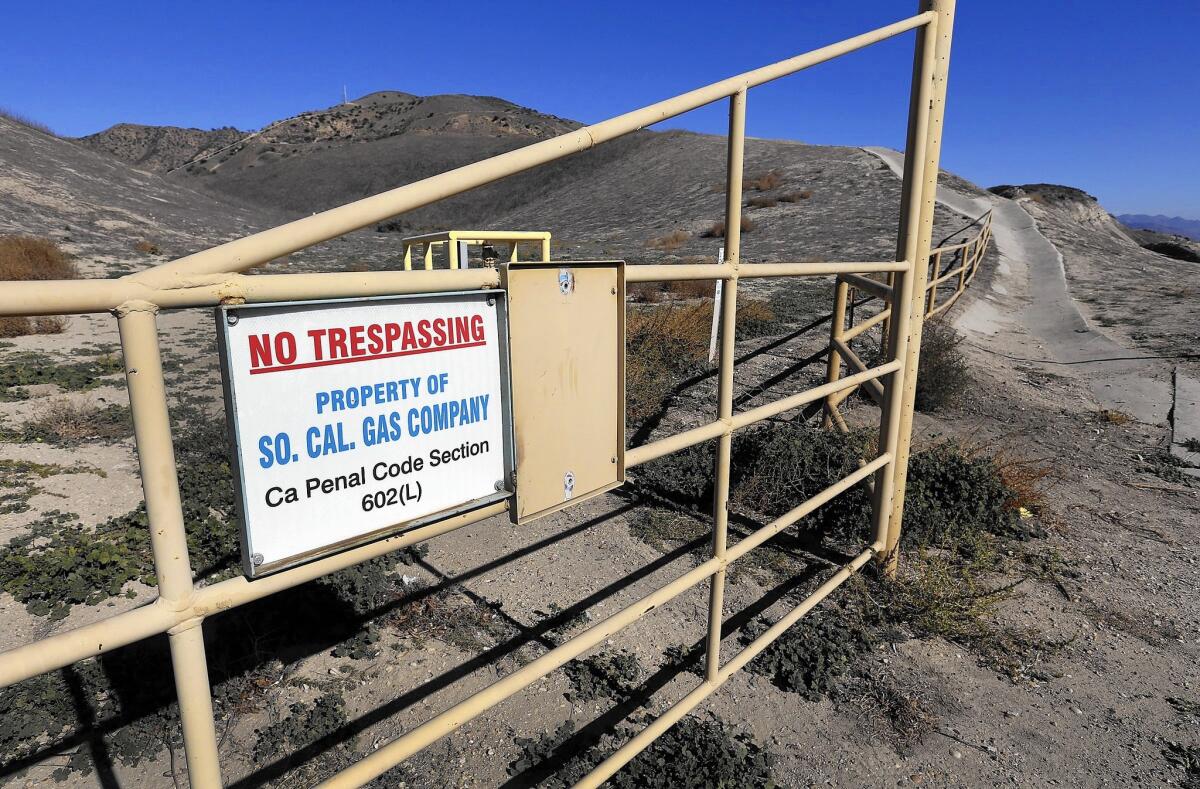Aliso Canyon leak prompts feds to recommend dozens of safety changes

- Share via
Almost a year after a massive natural gas leak forced thousands of Porter Ranch residents from their homes, a federal task force released a series of recommendations Tuesday to help prevent another such incident.
“We wanted to take advantage of the lessons learned from Aliso Canyon and analyze how we could apply those lessons to the more than 400 underground natural gas storage facilities in the country,” Franklin Orr, an undersecretary at the U.S. Department of Energy and one of the co-chairs of the task force, said in a conference call with reporters.
The task force made 44 specific recommendations in its 83-page report, and the U.S. Department of Transportation’s Pipeline and Hazardous Materials Safety Administration plans on issuing a rule by the end of this year to set national standards for underground natural storage sites.
“We’re looking at … how to make sure that nothing like Aliso Canyon happens any place else in the country,” said Marie-Therese Dominguez, co-chair of the task force.
Some of the task force’s recommendations centered on the aging state of storage sites. About 80% of the wells in the nation’s storage fields were completed before 1980, with the pipes at some sites originally designed for oil production instead of natural gas.
The task force also called for storage operators to phase out what is called “single-point-of-failure” well designs — that is, requiring a secondary barrier in the casing of a well for added safety.
“We really need to make sure the aging infrastructure associated with this is strong enough to maintain not only our energy reliability but also public health and preserve our environment,” Dominguez said.
The task force report identified 12 of the more than 400 underground storage facilities that, if suffering a major disruption of service, would potentially affect electric reliability by 2 gigawatts or more of generation capacity.
California is home to two of those facilities — Aliso Canyon, operated by Southern California Gas, and McDonald Island in San Joaquin County, operated by Pacific Gas & Electric. Eight of the 12 are in the Gulf Coast region — five in Mississippi and three in Louisiana.
“That’s one of the things we’re also calling for, data that will allow us to do a more detailed analysis of the vulnerabilities that exist there,” Orr said.
The October 2015 leak at the storage well operated by Southern California Gas Co. released about 95,000 tons of methane before being capped in February. Thousands of residents in the Porter Ranch neighborhood were displaced, with many complaining of headaches, nausea, nosebleeds and other symptoms.
California state agencies are monitoring the site and still testing the 114 wells at Aliso Canyon.
Southern California Gas officials said Tuesday that the company is reviewing the task force’s recommendations.
The utility, a subsidiary of San Diego-based Sempra Energy, said it has replaced the inner tubing with new pipe at every storage well that has been approved by the state’s Division of Oil, Gas and Geothermal Resources and said more than 40 miles of new piping have been installed.
“SoCalGas has cooperated fully with the task force and is committed to supporting forward-looking and reasonable regulations that promote safety at natural gas storage facilities,” company spokesman Chris Gilbride said.
Rep. Brad Sherman (D-Porter Ranch) issued a statement Tuesday saying the task force recommendations were “an important first step in protecting communities.”
But Sherman also criticized the report for not requiring sub-surface safety shutoff valves on every well.
Orr said shutoff valve requirements were discussed.
“It’s a bit of a balancing act because they provide some useful functions but they require more well interventions and more opportunities for maintenance issues and equipment problems,” he said.
Gas company officials said this summer that they were hoping some wells could be cleared for natural gas injections by September but that didn’t happen.
In an investors conference call in August, Sempra executives raised the latest cost figures for the leak to $717 million. The company says it has about $1 billion in insurance coverage and in August said it has begun to collect about $34 million off insurance policies.
Aliso Canyon has the largest daily deliverability — the amount of gas that can be withdrawn from a storage facility each day — of all the storage facilities west of the Rockies, estimated at 1.9 billion cubic feet per day.
Energy officials across the state have warned of potential power outages because of Aliso Canyon’s curtailment.
Some critics have said the need for underground natural gas storage sites is overblown but Orr disagreed.
“I think there is no question that both nationwide and in the L.A. Basin, there is a need for storage at times of highest demand,” Orr told reporters.
rob.nikolewski@sduniontribune.com
Nikolewski writes for the San Diego Union-Tribune.
UPDATES:
5:20 p.m.: This article has been updated throughout.
This article was originally published at 11:55 a.m.
More to Read
Inside the business of entertainment
The Wide Shot brings you news, analysis and insights on everything from streaming wars to production — and what it all means for the future.
You may occasionally receive promotional content from the Los Angeles Times.










